Last Phase of Indian National Movement Notes 12th History for Tnpsc Exam
Last Phase of Indian National Movement Notes 12th History for Tnpsc Exam
12th History Lesson 7 Notes in English
7] Last Phase of Indian National Movement
Introduction
- The outbreak of Second World War and Britain’s decision to involve India in the War without consulting Congress ministries in provinces, provoked the leaders of Indian National Congress and Gandhi.
- The Congress ministers resigned in protest. Gandhi launched the individual Satyagraha in October 1940 to keep up the morale of the Congress.
- In the meantime, the election of Subash Chandra Bose as Congress President upset Gandhi this led to Bose’s resignation.
- Later Bose started his Forward Bloc Party.
- After his escape to Germany and Singapore formed Indian National Army and carried on his revolutionary activities independent of the Congress movement.
- The Cripps Mission arrived in March 1942 to assuage the nationalists. But its proposals bore no fruit.
- Gandhi decided to embark on the Quit India Movement in August 1942.
- The British arrested all prominent leaders of the Congress and put down the movement with an iron hand.
- Gandhi languished in jail until May 1944. Then came the Cabinet Mission, whose plan was eventually accepted by the Congress.
- However, Jinnah and the Muslim League, persisting in their Pakistan demand, announced Direct Action Day programme that ignited communal riots in East Bengal.
- Gandhi began his tour in the riot-hit Naokali.
- Rajaji’s compromise formula and Wavell plan and the Simla conference convened to consider the latter’s plan did not help to resolve the deadlock.
- In the meantime, Royal Indian Navy revolted, prompting the British to quicken the process of Independence.
- Mountbatten was appointed governor general to oversee independence and the partition of the subcontinent into India and Pakistan.
12th History Book Back Questions
Individual Satyagraha
- Unlike in the past, where Gandhi’s campaign had assumed a mass character, Gandhi decided on the strategy of individual Satyagraha so that the war against fascism was not hampered.
- The satyagrahis were handpicked by Gandhi and their demand was restricted to asserting their freedom of speech to preach against participation in the war.
- The chosen satyagrahi was to inform the District Magistrate of the date, time and place of the protest.
- On reaching there at the appointed time, and publicly declare the following: ‘It is wrong to help the British War effort with men or money.
- The only worthy effort is to resist all war efforts with non-violent resistance’ and offer arrest.
- The programme began on October 17, 1940 with Vinobha Bhave offering Satyagraha near his Paunar ashram in Maharashtra.
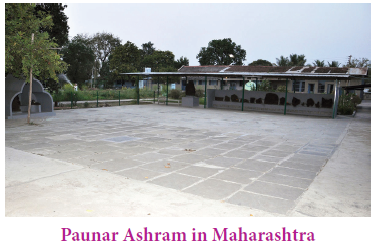
- Gandhi suspended the Satyagraha in December 1941.
- It was revived with some changes and groups offered satyagrahas from January 1941 and was eventually withdrawn in August 1941.
August Offer
- Individual Satyagraha was the Congress response to the August offer by the Viceroy, Lord Linlithgow.
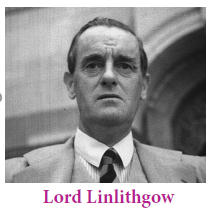
- On August 8, 1940, Linlithgow offered the following: Dominion status at some unspecified future; expansion of the Viceroy’s Council (or the Executive Council) to accommodate more Indians in it; setting up a War Advisory Council with Indians in it; recognition of the rights of the minority; and a promise to recognize the Indian peoples’ right to draft a constitution at some future date after the war.
Removal of Bose from Congress
- The August offer came too late for the Congress to even negotiate a settlement. The Congress, at this time, was losing its sheen.
- Its membership had fallen from 4.5 million in 1938–39 to 1.4 million in 1940-41.
- Subhas Chandra Bose was isolated within the Congress, as most leaders in the organisation’s top refused cooperation with him.
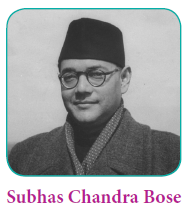
- Bose resigned and the AICC session at Calcutta elected Rajendra Prasad as president.
- Bose founded the Forward Bloc to function within the Congress and was eventually removed from all positions in the organization in August 1939.
Lahore Resolution
- The arrogance displayed by the colonial government and its refusal to find a meeting point between the promise of dominion status at some future date and
- The Congress demand for the promise of independence after cessation of the war as a pre-condition to support war efforts was drawn from another development.
- That was the demand for a separate nation for Muslims.
- Though the genesis of a separate unit or units consisting of Muslim majority regions in the Eastern and North-Western India was in the making since the 1930s, the resolution on March 23, 1940, at Lahore was distinct.
- There is ample evidence that the Muslim League and its associates were given the necessary encouragement to go for such a demand by the colonial administrators.
- The resolution, then, gave the colonial rulers a certain sense of courage to refuse negotiating with the Indian National Congress even while they sought cooperation in the war efforts.
- In many ways the Congress at the time was weaker in the organizational sense.
- Moreover, its leaders were committed to the idea that the British war efforts called for support given the character of the Axis powers – Germany, Italy and Japan – being fascist and thus a danger for democracy.
- Bose was the only leader who sought non-cooperation with the allied forces and active cooperation with the Axis powers.
- All these were the important markers of 1940. Things however changed soon with the Japanese advance in Southeast Asia and the collapse of the British army.
- It led to a sense of urgency among the colonial rulers to ensure cooperation for the war efforts in India even while not committing to freedom.
- Winston Churchill, now heading the war cabinet, dispatched Sir Stafford Cripps to talk with the Congress.
Cripps Mission

Japan Storm South-East Asia
- The year 1941 was bad for the allied forces.
- France, Poland, Belgium, Norway and Holland had fallen to Germany and Great Britain was facing destruction as well.
- Of far more significance to India was Japan’s march into South-east Asia.
- This was happening alongside the attack on Pearl Harbour, where Japanese war-planes bombed the American port on December 7, 1941.
- US President F.D. Roosevelt and Chinese President Chiang Kai-Shek were concerned with halting Japan on its march.
- India, thus, came on their radar and the two put pressure on British Prime Minister, Churchill to ensure cooperation for the war from the Indian people.
- By the end of 1941, the Japanese forces had stormed through the Philippines, Indo- China, Indonesia, Malaysia and Burma and were waiting to knock at India’s doors in the North-East.
- The way the South East Asian region fell raised concerns to Britain and the Indian National Congress.
- The British forces ran without offering any resistance.
- The Indian soldiers of the British Indian Army were left to the mercy of the Japanese forces.
- It was from among them that what would later on to become the Indian National Army (INA) would be raised.
- We will study that in detail in this lesson. Churchill was worried that Calcutta and Madras might fall in Japanese hands.
- Similar thoughts ran in the minds of the leaders of the Congress too and they too were desperate to seek an honourable way out to offer cooperation in the war effort.
- It was in this situation that the Congress Working Committee, in December 1941, passed a resolution offering cooperation with the war effort on condition that Britain promised independence to India after the war and transfer power to Indians in a substantial sense immediately.
Arrival of Cripps
- A delegation headed by Sir Stafford Cripps reached India in March 1942.
- That Cripps, a Labour party representative in the War cabinet under Churchill, was chosen to head the delegation lent credibility to the mission.
- Before setting out to India, he announced that British policy in India aimed at ‘the earliest possible realisation of self-government in India’.
- But the draft declaration he presented before he began negotiations fell far short of independence.
Cripps Proposals
- Cripps promised Dominion Status and a constitution-making body after the war.
- The constitution making body was to be partly elected by the provincial assemblies and nominated members from the Princely states.
- The draft also spelt out the prospect of Pakistan.
- It said that any province that was not prepared to accept the new constitution would have the right to enter into a separate agreement with Britain regarding its future status.
- The draft did not contain anything new.
- Nehru recalled later: ‘When I read these proposals for the first time I was profoundly depressed.’
Rejection of Cripps’ Proposals
- The offer of Dominion Status was too little.
- The Congress also rejected the idea of nominated members to the constitution-making body and sought elections in the Princely States as in the Provinces.
- Above all these was the possibility of partition.
- The negotiations were bound to breakdown and it did.
Options for Congress in the wake of Pearl Harbour Attack
- Churchill’s attitude towards the Indian National Movement for independence in general and Gandhi in particular was one of contempt even earlier.
- He did not change even when Britain needed cooperation in the war efforts so desperately.
- But he came under pressure from the US and China. The Indian National Congress, meanwhile, was pushed against the wall.
- This happened in two ways: the colonial government’s adamant stand against any assurance of independence on the one hand and Subhas Bose’s campaign to join hands with the Axis powers in the fight for independence.
- Bose had addressed the people of India on the Azad Hind Radio broadcast from Germany in March 1942.
- This was the context in which Gandhi thought of the Quit India movement.
Quit India Movement
- Sometime in May 1942 Gandhi took it upon himself to steer the Indian National Congress into action.
- Gandhi’s decision to launch a mass struggle this time, however, met with reservation from C. Rajagopalachari as much as from Nehru.
- Conditions were ripe for an agitation.
- Prices of commodities had shot up many-fold and there was shortage of food grains too.
Congress Meet at Wardha
- It was in this context that the Working Committee of the Indian National Congress met at Wardha on July 14, 1942.
- The meeting resolved to launch a mass civil disobedience movement.
- C. Rajagopalachari and Bhulabhai Desai who had reservations against launching a movement at that time resigned from the Congress Working Committee.
- Nehru, despite being among those who did not want a movement then bound himself with the majority’s decision in the Working Committee.
‘Do or Die’
- The futility that marked the Cripps mission had turned both Gandhi and Nehru sour with the British than any time in the past.
- Gandhi expressed this in a press interview on May 16, 1942 where he said: ‘Leave India to God.
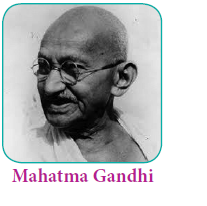
- If that is too much, then leave her to anarchy.
- This ordered disciplined anarchy should go and if there is complete lawlessness, I would risk it.’
- The Mahatma called upon the people to ‘Do or Die’ and called the movement he launched from there as a ‘fight to the finish’.
Quit India
- The colonial government did not wait.
- All the leaders of the Indian National Congress, including Gandhi, were arrested early in the morning on August 9, 1942.
- The Indian people too did not wait.
- The immediate response to the pre-dawn arrests was hartals in almost all the towns where the people clashed, often violently, with the police.
- Industrial workers across India went on strike. The Tata Steel Plant in Jamshedpur closed down by the striking workers for 13 days beginning August 20.
- The textile workers in Ahmedabad struck work for more than three months.
- Industrial towns witnessed strikes for varied periods across India.
Brutal Repression
- The colonial government responded with brutal repression and police resorted to firing in many places.
- The army was called into suppress the protest.
- The intensity of the movement and the repression can be made out from the fact that as many as 57 battalions were called in as a whole.
- Aircrafts were used to strafe protesters.
- The momentum and its intensity was such that Linlithgow, wrote to Churchill, describing the protests as ‘by far the most serious rebellion since 1857,
- The gravity and extent of which we have so far concealed from the world for reasons of military security.’
- Though this phase of the protest, predominantly urban, involving the industrial workers and the students was put down by use of brutal force, the upsurge did not end.
- It spread in its second phase into the villages.
- A sixty-point increase in prices of food-grains recorded between April and August 1942 had laid the seeds of resentment.
- In addition, those leaders of the Congress, particularly the Socialists within, who had managed to escape arrest on August 9 fanned into the countryside where they organised the youth into guerrilla actions.
Outbreak of Violence
- Beginning late September 1942, the movement took the shape of attacks and destruction of communication facilities such as telegraph lines, railway stations and tracks and setting fire to government offices.
- This spread across the country and was most intense in Eastern United Provinces, Bihar, Maharashtra and in Bengal.
- The rebels even set up ‘national governments’ in pockets they liberated from the colonial administration.
- An instance of this was the ‘Tamluk Jatiya Sarkar’ in the Midnapore district in Bengal that lasted until September 1944. There was a parallel government in Satara.
- Socialists like Jayaprakash Narayan, Achyut Patwardhan, Asaf Ali, Yusuf Mehraly and Ram Manohar Lohia provided leadership.
- Gandhi’s 21 day fast in jail, beginning February 10, 1943, marked a turning point and gave the movement (and even the violence in a limited sense) a great push.
Spread and Intensity of the Movement
- The spread of the movement and its intensity can be gauged from the extent of force that the colonial administration used to put it down.
- By the end of 1943, the number of persons arrested across India stood at 91, 836.
- The police shot dead 1060 persons during the same period.
- 208 police outposts, 332 railway stations and 945 post offices were destroyed or damaged very badly.
- At least 205 policemen defected and joined the rebels. R.H. Niblett, who served as District Collector of Azamgarh in eastern United Province, removed from service for being too mild with the rebels,
- recorded in his diary that the British unleashed ‘white terror’ using an ‘incendiary police to set fire to villages for several miles’ and that ‘reprisals (becoming) the rule of the day.’
- Collective fines were imposed on all the people in a village where public property was destroyed.
Clandestine Radio
- Yet another prominent feature of the Quit India movement was the use of Radio by the rebels.
- The press being censored, the rebels set up a clandestine radio broadcast system from Bombay.
- The transmitter was shifted from one place to another in and around the city.
- Usha Mehta was the force behind the clandestine radio operations and its broadcast was heard as far away as Madras.
- The Quit India movement was the most powerful onslaught against the colonial state hitherto.
- The movement included the Congress, the Socialists, and the Forward Bloc.
- The movement witnessed unprecedented unity of the people and sent a message that the colonial rulers could not ignore.
Release of Gandhi
- Gandhi’s release from prison, on health grounds, on May 6, 1944 led to the revival of the Constructive Programme.
- Congress committees began activities in its garb and the ban on the Congress imposed in the wake of the Quit India movement was thus overcome.
- The colonial state, meanwhile, put forward a plan for negotiation.
- Lord Archibald Wavell, who had replaced Linlithgow as Viceroy in October 1943, had begun to work towards another round of negotiation.
- The message was clear: The British had no option but to negotiate!
Netaji Subhas Chandra Bose and the INA
- A considerably large contingent of the Indian Army was posted on the South East Asian countries that were part of the British Empire.
- They were in Malaya, Burma and elsewhere. The forces, however, could not stand up to the Japanese army.

- The command of the British Indian Army in the South-East Asian front simply retreated leaving the ranks behind as Prisoners of War (POWs).
- Mohan Singh, an officer of the British Indian Army in Malaya, approached the Japanese for help and they found in this an opportunity.
- Japan’s interests lay in colonising China and not much India. The Indian POWs with the Japanese were left under Mohan Singh’s command.
- The fall of Singapore to the Japanese forces added to the strength of the POWs and Mohan Singh now had 45,000 POWs under his command.
- Of these, Mohan Singh had drafted about 40,000 men in the Indian National Army by the end of 1942.
- Indians in the region saw the INA as saviours against Japanese expansionism as much as the commander and other officers held out that the army would march into India but only on invitation from the Indian National Congress.
- On July 2, 1943, Subhas Chandra Bose, reached Singapore.
- From there he went to Tokyo and after a meeting with Prime Minister Tojo, the Japanese leader declared that his country did not desire territorial expansion into India.
- Bose returned to Singapore and set up the Provisional Government of Free India on October 21, 1943.
- This Provisional Government declared war against Britain and the other allied nations.
- The Axis powers recognised Bose’s Provisional Government as its ally.
- After the Indian National Congress acted against Bose in August 1939, shunting him out of all offices including as president of the Bengal Congress Committee,
- Bose embarked upon a campaign trail, to mobilise support to his position, across India.
- He was arrested by the British on July 3, 1940 under the Defence of India Act and kept under constant surveillance.
- As the war progressed in Europe Bose believed that Germany was going to win.
- He began to nurture the idea that Indian independence could be achieved by joining hands with the Axis powers.
- In the midnight of January 16-17, 1941, Bose slipped out of Calcutta, and reached Berlin by the end of March, travelling through Kabul and the Soviet Union on an Italian passport.
- Bose met Hitler and Goebbels in Berlin. Both the Nazi leaders were cold and the only concession they gave was to set up the Azad Hind Radio.
- Nothing more came out of his rendezvous with Hitler and his aides.
- With Germany facing reverses, Bose found his way to Singapore in July 1943
Subash and INA
- Bose enlisted civilians too into the INA and one of the regiments was made up of women.
- The Rani of Jhansi regiment of the INA was commanded by a medical doctor and daughter of freedom fighter Ammu Swaminathan from Madras, Dr Lakshmi.
- On July 6, 1944, Subhas Bose addressed a message to Gandhi over the Azad Hind Radio from Rangoon.
- Calling him the ‘Father of the Nation’, Bose appealed to Gandhi for his blessing in what he described as ‘India’s last war of independence.’
INA with Axis Powers in War
- A battalion of the INA commanded by Shah Nawaz accompanied the Japanese army, in its march on Imphal.
- This was in late 1944 and the Axis powers, including the Japanese forces, had fallen into bad times all over.
- The Imphal campaign did not succeed and the Japanese retreated before the final surrender to the British command in mid-1945.
- Shah Nawaz and his soldiers of the INA were taken prisoners and charged with treason.
INA Trial
- The INA trials were held at the Red Fort in New Delhi.
- The Indian National Congress fielded its best lawyers in defence of the INA soldiers.
- Nehru, who had given up his legal practice as early as in 1920 responding to Gandhi’s call for non-cooperation, wore his black gown to appear in defence.
- Even though the INA did not achieve much militarily, the trials made a huge impact in inspiring the masses.
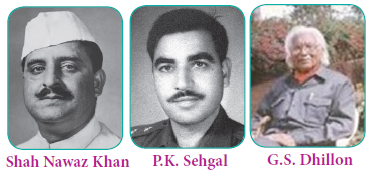
- The colonial government’s arrogance once again set the stage for another mass mobilisation.
- The Indian National Congress, after the debacle at the Simla Conference (June 25 and July 14, 1945) plunged into reaching out to the masses by way of public meetings across the country.
- The INA figured more prominently as an issue in all these meetings than even the Congress’s pitch for votes in the elections (under the 1935 Act) that were expected soon.
- It was in this context that the colonial rulers sent up three prominent officers of the INA – Shah Nawaz Khan, P.K. Sehgal and G.S. Dhillon – to trial.
- The press in India reported the trials with all empathy and editorials sought the soldiers freed immediately.
- The INA week was marked by processions, hartals and even general strikes across the nation demanding release of the soldiers.
- The choice of the three men to be sent up for trial ended up rallying all political opinion behind the campaign.
- The Muslim League, the Shiromani Akali Dal and the Hindu Maha Sabha, all those who had stayed clear of the Quit India campaign, joined the protests and raised funds for their defence.
- Although the trial court found Sehgal, Dhillon and Shah Nawaz Khan guilty of treason, the commander in chief remitted the sentences and set them free on January 6, 1946.
- The INA trials, indeed, set the stage for yet another important stage in the history of the Indian National Movement in February 1946.
- The ratings of the Royal Indian Navy (RIN) raised the banner of revolt.
The Royal Indian Navy Revolt
- The economic impact of the war was manifest in rising prices, shortage of food- grains and closure of war time industries causing retrenchment and employment.
- This merged with the anti-British sentiments evident in the mass scale of the protests revolving around the INA trials.
- B.C. Dutt, a rating (the designation for the Indians employed in the various war-ships and elsewhere in the Royal Indian Navy) in the HMIS Talwar was arrested for scribbling ‘Quit India’ on the panel of the ship.
- This provoked a strike by the 1,100 ratings on the ship.
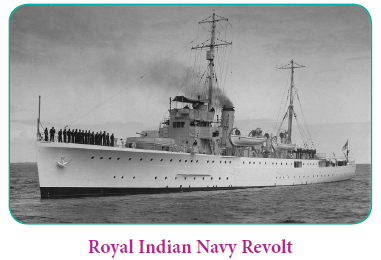
- The ratings resented the racist behaviour of the English commanders, the poor quality of the food and abuses that were the norm.
- Dutt’s arrest served as the trigger for the revolt on February 18, 1946.
- The day after, the revolt was joined by the ratings in the Fort Barracks and the Castle and a large number of them went into the Bombay cities in commandeered trucks waving Congress flags and shouting anti-British slogans.
- Soon, the workers in the textile mills of Bombay joined the struggle.
- The trade unions in Bombay and Calcutta called for a sympathy strike and the two cities turned into war zones.
- Barricades were erected all over and pitched battles fought. Shopkeepers downed shutters and hartals became the order of the day.
- Trains were stopped in the two cities with people sitting on the tracks.
- On news of the Bombay revolt reaching Karachi, ratings in the HMIS Hindustan and other naval establishments in Karachi went on a lightning strike on February 19.
- The strike wave spread to almost all the naval establishments across India and at least 20,000 ratings from 78 ships and 20 shore establishments ended up revolting in the days after February 18, 1946.
- There were strikes, expressing support to the ratings in the Royal Indian Air Force stationed in Bombay, Poona, Calcutta, Jessore and Ambala units.
- The sepoys in the army cantonment station at Jabalpur too went on strike.
- The ratings, in many places, hoisted the Congress, the Communist, and the Muslim League flags together on the ship masts during the revolt.
- The colonial government’s response was brutal repression.
- It was, indeed, a revolt without a leadership; nor did the ratings move in an organised direction.
- While the trade unions came out in solidarity with the ratings in no time and the strikes in Bombay and Calcutta and Madras were strong expressions against British rule in India, these did not last for long and the ratings were forced to surrender soon.
- Sardar Vallabhai Patel, then in Bombay, took the initiative to bring the revolt to an end.
- The RIN mutiny, however, was indeed a glorious chapter in the Indian National Movement and perhaps the last act of rebellion in the long story of such acts of valour in the cause of independence.
- The March 23, 1940 resolution read as follows: ‘That geographically contiguous units are demarcated into regions which should be so constituted,
- With such territorial readjustments as may be necessary, that the areas in which the Muslims are numerically in a majority as in the north-western and eastern zones of India should be grouped to constitute “Independent States”, in which the constituent units shall be autonomous and sovereign.’ (Source: Sumit Sarkar Modern India 1885-1947, Pearson, 2018, p 324)
Rajaji Proposals and the Wavell Plan

Demand for a Separate Nation
- Meanwhile, the communal challenge persisted and the Muslim League pressed with its demand for a separate nation.
- The Lahore resolution of the Muslim League in March 1940 had altered the discourse from the Muslims being a ‘minority’ to the Muslims constituting a ‘nation’.
- Mohammed Ali Jinnah was asserting this right as the sole spokesperson of the community.
Rajaji’s Proposals
- In April 1944, when the Congress leaders were in jail, C.Rajagopalachari put out a proposal to resolve the issue.
- It contained the following: A post-war commission to be formed to demarcate the contiguous districts where the Muslims were in absolute majority and a plebiscite of the adult population there to ascertain whether they would prefer Pakistan;
- In case of a partition there would be a mutual agreement to run certain essential services, like defence or communication;
- The border districts could choose to join either of the two sovereign states; The implementation of the scheme would wait till after full transfer of power.
- After his release from prison, Gandhi, in July 1944, proposed talks with Jinnah based on what came to be the ‘Rajaji formula’.
- The talks did not go anywhere.
Wavell Plan
- In June 1945 Lord Wavell moved to negotiate and called for the Simla conference.
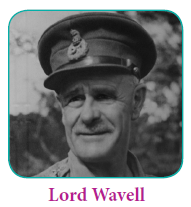
- The rest of the Congress leaders, including Jawaharlal Nehru, Sardar Patel and the Congress president, Maulana Abul Kalam Azad were released from jail for this.
- Wavell had set out on this project in March 1945 and sailed to London.
- There he convinced Churchill of the imperative for a Congress–Muslim League coalition government as a way to deal with the post-war political crisis.
- The Viceroy’s proposal before the leaders of all political formations and most prominently the Congress and the Muslim League was setting up of an Executive Council,
- exclusively with Indians along with himself and the commander in- chief;
- equal number of representatives in the council for the caste Hindus and the Muslims and separate representation for the Scheduled Castes;
- And start of discussions for a new constitution.
- The proposal displeased everyone.
- The Simla Conference held between June 25 and July 14, 1945 ended without resolution.
- The talks broke down on the right of the Indian National Congress and the Muslim League to nominate members to the Viceroy’s Council.
- The Muslim League insisted on its exclusive right to nominate Muslim members to the Council.
- Its demand was that the Congress nominees shall only be caste Hindus and that the Indian National Congress should not nominate a Muslim or a member from the Scheduled Caste!
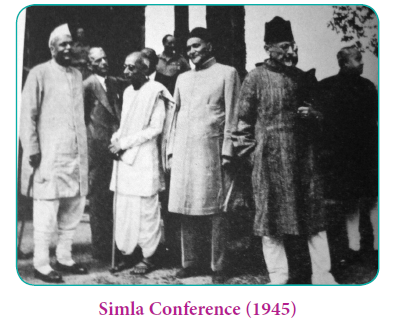
- This was seen as a means to further the divide on communal lines and deny the Congress the status of representing the Indian people.
- Lord Wavell found a council without Muslim League representation as unworkable and thus abandoned the Simla talks.
- The years between the Lahore resolution of 1940 and the Simla Conference in 1945 marked the consolidation of a Muslim national identity and the emergence of Jinnah as its sole spokesperson.
- It was at a convention of Muslim League Legislators in Delhi in April 1946, that Pakistan was defined as a ‘sovereign independent state’.
- For the first time the League also declared its composition in geographical terms as ‘the region consisting of the Muslim majority provinces of Bengal and Assam in the Northeast and the Punjab, North-West Frontier Province, Sind and Baluchistan in the Northwest.
- The Congress president Maulana Abul Kalam Azad rejected this idea and held that the Congress stood for a united India with complete independence.
- All these were developments after the Simla conference of June–July 1945 and after Churchill was voted out and replaced by a Labour Party government headed by Clement Attlee.
- Times had changed in a substantial sense. British Prime Minister, Attlee had declared the certainty of independence to India with only the terms left to be decided.
Mountbatten Plan
Cabinet Mission
- The changed global scenario in the post– World War II context led to the setting up of the Cabinet Mission.
- Headed by Secretary of State for India, Sir Stafford Cripps, and A.V. Alexander, the mission landed in India in March 1946 and began work on its brief: to set up a national government before the final transfer of power.
- The mission proposed to constitute a ‘representative’ body by way of elections across the provinces and the princely states and entrust this body with the task of making a constitution for free India.
- The idea of partition did not figure at this stage.
- Instead, the mission’s proposal was for a loose-knit confederation in which the Muslim League could dominate the administration in the North-East and North- West provinces while the Congress would administer rest of the provinces.
- Jinnah sounded out his acceptance of the idea on June 6, 1946.
- The Congress, meanwhile, perceived the Cabinet Mission’s plan as a clear sanction for the setting up of a Constituent Assembly.
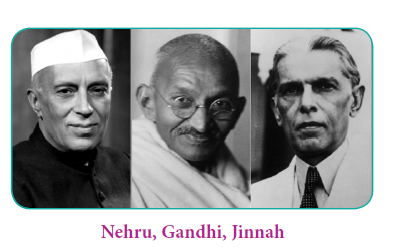
- Nehru conveyed through his speech at the AICC, on July 7, 1946, that the Indian National Congress accepted the proposal.
- Subsequently, Jinnah on July 29, 1946, reacted to this and announced that the League stood opposed to the plan.
- After elaborate consultations, the viceroy issued invitations on 15 June 1946 to the 14 men to join the interim government.
- The invitees were: Jawaharlal Nehru, Vallabhbhai Patel, Rajendra Prasad, C. Rajagopalachari and Hari Krishna Mahtab (on behalf of the INC);
- Mohammed Ali Jinnah, Liaquat Ali Khan, Mohammed Ismail Khan, Khwaja Sir Nazimuddin and Abdul Rab Nishtar (from the Muslim League) and Sardar Baldev Singh (on behalf of the Sikh community),
- Sir N.P. Engineer (to represent the Parsis), Jagjivan Ram (representing the scheduled castes) and John Mathai (as representative of the Indian Christians).
- Meanwhile, the Congress proposed Zakir Hussain from its quota of five nominees to the interim council.

- The Muslim League objected to this and, on 29 July 1946, Jinnah announced that the League would not participate in the process to form the Constituent Assembly.
- This invited a sharp reaction from the British administration.
- On 12 August 1946, the viceroy announced that he was inviting Nehru (Congress president) to form the provisional government.
- After consultation with Nehru, 12 members of the National Interim Government were announced on 25 August 1946.
- Apart from Nehru, the other members were: Vallabhbhai Patel, Rajendra Prasad, Asaf Ali, C. Rajagopalachari, Sarat Chandra Bose, John Mathai, Sardar Baldev Singh, Sir Shafaat Ahmed Khan, Jagjivan Ram, Syed Ali Zaheer and Cooverji Hormusji Bhabha.
- It was stated that two more Muslims will be nominated in due course.
- Five Hindus, three Muslims and one representative each from the scheduled castes, Indian Christians, Sikhs and Parsis formed the basis of this list.
- Later Hare Krishna Mahtab was replaced by Sarat Chandra Bose.
- The Parsi nominee, N.P. Engineer was replaced by Cooverji Hormusji Bhabha.
- In place of the League’s nominees, the Congress put in the names of three of its own men: Asaf Ali, Shafaat Ahmed Khan and Syed Ali Zaheer.
- The League, meanwhile, gave a call for ‘Direct Action’ on 16 August 1946.
- There was bloodshed in Calcutta and several other places, including in Delhi.
- This was when Gandhi set out on his own course to arrive in Calcutta and decided to stay on at a deserted house in Beliaghatta, a locality that was worst affected, accompanied only by a handful of followers.
- Muslims who were hounded out of their homes in Delhi were held in transit camps (in Purana Quila and other places).
- It was only after Gandhi arrived there (on 9 September 1946) and conveyed that the Muslims were Indian nationals and hence must be protected by the Indian state (Nehru by then was the head of the interim government) that the Delhi authorities began organising rations and building latrines.
- It was in this context that the Congress agreed to the constitution of the interim government.
- Nehru assumed office on 2 September 1946.
- Yet another round of communal violence broke out across the country and more prominently in Bombay and Ahmedabad.
- Lord Wavell set out on another round of discussion and after sounding out Nehru, he proposed, once again, to Jinnah that the League participate in the interim government.
- The Muslim League accepted the proposal but Jinnah refused to join the cabinet. The interim cabinet was reconstituted on October 26, 1946.
- Those who joined on behalf of the League were Liaquat Ali Khan, I.I. Chundrigar, A. R. Nishtar, Ghazanfar Ali Khan and Jogendra Nath Mandal.
- But there was no let-up in the animosity between the Congress and the League and this was reflected in the functioning (rather non-functioning) of the interim council of ministers.
- The League, meanwhile, was determined against cooperating in the making of the constituent assembly.
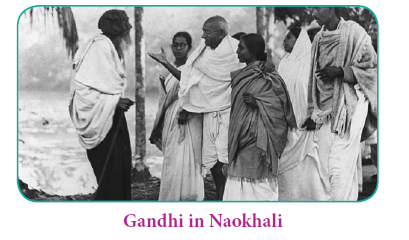
- At another level, the nation was in the grip of communal violence of unprecedented magnitude.
- Naokhali in East Bengal was ravaged by communal violence.
- The members of the League who were part of the interim government refused to participate in the ‘informal’ consultations that Nehru held before the formal meeting of the cabinet in the viceroy’s presence.
- The Muslim League, it seemed, were determined to wreck the interim government from within.
- While the Congress scored impressive victories in the July–August 1946 elections and secured 199 from out of the 210 general seats, the Muslim League did equally well in seats reserved for the Muslims.
- The League’s tally was 76. All but one of the 76 seats came from the Muslim-reserved constituencies.
- The League, however, decided against participating in the Constituent Assembly.
- Hence, only 207 members attended the first session of the Constituent Assembly on 9 December 1946.
- Meanwhile the functioning of the interim government was far from smooth with animosity between the Congress and the League growing by the day.
- The ‘informal’ meetings of the cabinet intended to settle differences before any proposal was taken to the formal meeting that the Viceroy presided over, could not be held from the very beginning.
- The proverbial last straw was the budget proposals presented by Liaquat Ali Khan in March 1947.
- The finance minister proposed a variety of taxes on industry and trade and proposed a commission to go into the affairs of about 150 big business houses and inquire into the allegations of tax evasion against them.
- Khan called this a ‘socialistic budget’.
- This, indeed, was a calculated bid to hit the Indian industrialists who had, by this time, emerged as the most powerful supporters of the Congress.
- The intention was clear: to hasten the partition and prove that there was no way that the League and the Congress could work together towards independence.
- British Prime Minister Atlee’s statement in Parliament on February 20, 1947, that the British were firm on their intention to leave India by June 1948 set the pace for another stage.
- Lord Wavell was replaced as Viceroy by Lord Mountbatten on March 22, 1947.
Mountbatten Plan
- Mountbatten came up with a definite plan for partition. It involved splitting up Punjab into West and East (where the west would go to Pakistan) and similar division of Bengal wherein the Western parts will remain in India and the East become Pakistan.
- The Congress Working Committee, on 1 May 1947, conveyed its acceptance of the idea of partition to Mountbatten.
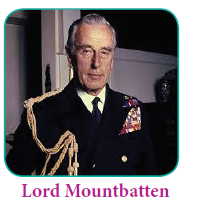
- The viceroy left for London soon after and on his return disclosed the blueprint for partition and, more importantly, the desire to advance the date of British withdrawal to 15 August 1947.
- There were only 11 weeks left between then and the eventual day of independence. The AICC met on 15 June 1947.
- It was here that the resolution, moved by Govind Ballabh Pant, accepting partition, was approved.
- It required the persuasive powers of Nehru and Patel as well as the moral authority of Gandhi to get the majority in the AICC in favour of the resolution.
- The period between March 1946 and 15 August 1947 saw many tumultuous events such as
(i) the setting up of the Cabinet Mission,
(ii) the formation of the interim government,
(iii) the birth of the Constituent Assembly and
(iv) the widening of rift between the Congress and the Muslim League leading to the partition and finally the dawn of independence.